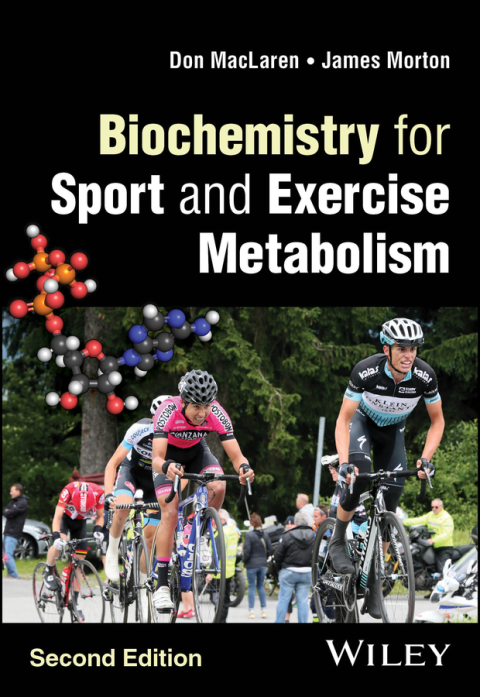Description
Efnisyfirlit
- Cover
- Table of Contents
- Title Page
- Copyright
- Preface
- 1 Energy Sources for Muscular Activity
- 1.1 Adenosine Triphosphate: The Energy Currency
- 1.2 Energy Continuum
- 1.3 Energy Supply for Muscle Contraction
- 1.4 Energy Systems and Running Speed
- 1.5 Why Can’t a Marathon be Sprinted?
- 1.6 Energy Sources and Muscle
- 1.7 Can Muscle Use Protein for Energy?
- 1.8 Key Points
- References
- 2 Skeletal Muscle Structure and Function
- 2.1 Skeletal Muscle Structure
- 2.2 Muscle Contraction
- 2.3 Muscle Fibre Types
- 2.4 Muscles in Action
- 2.5 Key Points
- References
- 3 Biochemical Concepts
- 3.1 Organization of Matter
- 3.2 Chemical Bonding
- 3.3 Chemical Reactions, ATP and Energy
- 3.4 Water
- 3.5 Solutions and Concentrations
- 3.6 Acid–Base Balance
- 3.7 Cell Structure
- 3.8 Key Points
- References
- 4 Proteins
- 4.1 Protein Function
- 4.2 Amino Acids
- 4.3 Protein Structure
- 4.4 Proteins as Enzymes
- 4.5 Protein Turnover
- 4.6 Amino Acid Metabolism
- 4.7 Key Points
- References
- 5 Carbohydrates
- 5.1 Relevance of Carbohydrates for Sport and Exercise
- 5.2 Types and Structure of Carbohydrates
- 5.3 Metabolism of Carbohydrates
- 5.4 Key Points
- References
- 6 Lipids
- 6.1 Relevance of Lipids for Sport and Exercise
- 6.2 Structure of Lipids
- 6.3 Metabolism of Lipids
- 6.4 Key Points
- References
- 7 Principles of Metabolic Regulation
- 7.1 Introduction
- 7.2 Hormones
- 7.3 Peptide Hormones, Neurotransmitters and Regulation
- 7.4 Steroid Hormones and Regulation
- 7.5 Allosteric Effectors
- 7.6 Exercise-Induced Transcription Factors
- 7.7 Regulators of Transcription
- 7.8 Training Responses
- 7.9 Impact of Nutrition
- 7.10 Key Points
- References
- 8 Techniques for Exercise Metabolism
- 8.1 Introduction
- 8.2 Respiratory Analysis
- 8.3 Ergometry
- 8.4 Blood Sampling and Analysis
- 8.5 Metabolomics
- 8.6 a-v Differences
- 8.7 Muscle Biopsy
- 8.8 Nuclear Magnetic Resonance (NMR) Magnetic Resonance Spectroscopy (MRS)
- 8.9 Use of Isotopes
- 8.10 Key Points
- References
- 9 High-Intensity Exercise (HIE)
- 9.1 Overview of Energy Production and Metabolic Regulation in High-Intensity Exercise
- 9.2 Effects of Exercise Duration
- 9.3 Effects of Nutritional Status
- 9.4 Effects of Training
- 9.5 Mechanisms of Fatigue
- 9.6 Resistance Exercise
- 9.7 Key Points
- References
- 10 Endurance Exercise
- 10.1 Overview of Energy Production and Metabolic Regulation in Endurance Exercise
- 10.2 Effects of Exercise Intensity
- 10.3 Effects of Exercise Duration
- 10.4 Effects of Nutritional Status
- 10.5 Effects of Training Status
- 10.6 Mechanisms of Fatigue
- 10.7 Key Points
- References
- 11 High-intensity Intermittent Exercise
- 11.1 Overview of Energy Production in Intermittent Exercise
- 11.2 Metabolic Regulation in Intermittent Exercise
- 11.3 Effects of Manipulating Work–Rest Intensity and Ratio
- 11.4 Effects of Nutritional Status
- 11.5 Muscle Adaptations to Interval Training
- 11.6 Mechanisms of Fatigue
- 11.7 Key Points
- References
- Index
- End User License Agreement






Reviews
There are no reviews yet.